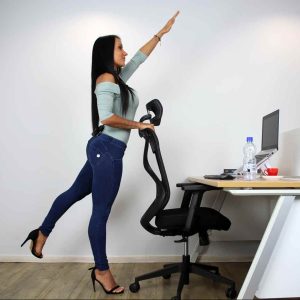
Types of Leather: Understanding Your Options
Leather, Bonded Leather or Faux Leather Office Chair?
There are big differences between the types of leather used for office chairs.
Have you ever bought an ergonomic office chair, only to find your back still hurts after a long day? Maybe you’ve heard of orthopedic office chairs but aren’t sure if they’re any different, or if it's just marketing hype. You’re not alone. Many people invest in the wrong chair and still struggle with lower back pain, neck tension, or even sciatica. The good news? Once you understand the difference between ergonomic and orthopedic chairs, you can make a confident choice that supports your health instead of working against it.
As an Office Ergonomics Risk Facilitator, I’ve helped hundreds of people find seating solutions that reduce pain and improve comfort. In this guide, I’ll break down the two chair types in simple terms, compare their key features, and show you which one is best if you’re already dealing with back pain, or just want to prevent it. By the end, you’ll know exactly which chair belongs in your workspace so you can sit comfortably, protect your back, and work at your best.
An ergonomic office chair is designed for the average person who spends long hours sitting at a desk. Its main goal? Prevent pain before it starts.
Think of it as your everyday posture coach. Ergonomic chairs encourage proper alignment of your spine, shoulders, and hips, reducing the risk of strain from sitting too long. A critical aspect of any ergonomic office chair is ADJUSTABILITY - Why a fully adjustable office chair is important.
Ergonomic chairs are general-purpose solutions focused on promoting good posture and preventing discomfort. Orthopedic chairs are advanced options for anyone already struggling with lower back pain.
Ergonomic Chairs are best for: People without chronic pain who want to stay comfortable and supported throughout the day.
An orthopedic office chair takes things further. It’s designed for people already dealing with musculoskeletal conditions like sciatica, or chronic back pain.
Medical professionals often recommend these chairs because they don’t just prevent discomfort—they actively help relieve it.
Orthopedic chairs are best for: Anyone with pre-existing conditions like persistent back pain, or sciatica.
Orthopedic chairs include everything an ergonomic chair offers, plus advanced support features:


By independently controlling the angles between the backrest and the seat, orthopedic office chairs may alleviate, and even rehabilitate certain medical preconditions, specifically musculoskeletal issues of the spine like sciatica. What actually happens when you sit?
The free-float mechanism on an orthopedic office chair allows the seat to be adjusted to a forward sloping position. This reduces the disc pressure in the lumbar region of the back.
The forward slope, or negative tilt, is typically limited to a maximum of 5 degrees.
| Feature | Ergonomic chair | Orthopedic chair |
|---|---|---|
| Swivel and Tilt Mechanism | Synchronous (synchro) | Fully independent free-float mechanism |
| Seat Foam | High-density automotive grade moulded foam | High-density automotive grade moulded foam |
| Seat angle adjustment | Linked to the backrest movement | Fully independent and lockable in any position |
| Negative tilt (forward sloping) seat adjustment | No | Yes, up to 5 degrees |
| Backrest angle adjustment | Yes, linked to synchronous mechanism. | Yes, fully independent and lockable in any position |
| Backrest height adjustment | Optional | Optional |
| Lumbar support | Yes, on higher-end ergonomic chairs | Yes |
| Best for | Preventing discomfort | Relieving existing back conditions |
Key takeaway: If you’re generally healthy and want comfort and prevention, go ergonomic.
If you have sciatica or chronic back pain, orthopedic is the better choice.
Choosing the right chair isn’t just about comfort, it’s about your health and how you work every day. In this video, we compare two chairs from our range to explain the key differences:
If you’re taller, broader, or need a chair that supports extra weight, a standard task chair may not cut it. Heavy-duty orthopedic chairs combine strength and medical-grade support, making them a smart investment for both comfort and durability. Typical examples include:
Sciatica happens when the sciatic nerve is pinched, often leading to sharp lower-back and leg pain.
For sciatica relief, you need:
That makes an orthopedic office chair the best choice for sciatica sufferers.
Before you decide, ask yourself:
Remember: There is no and never will be a one-size-fits-all. The best office chair is the one that fits your body, your health, and your work style.
Now you know the real difference between an ergonomic office chair and an orthopedic one, and why those labels shouldn’t be used interchangeably.
REMEMBER: Your chair is only part of the equation. For the best results, make sure your chair, desk, and monitor are set up correctly. What is the correct ergonomic height for my desk, computer monitor and office chair? If you’re still unsure which chair is right for you, contact us or visit our showroom where our team will help you find the perfect fit.
As an Office Ergonomics Risk Facilitator, I’ve seen first-hand how the right chair can transform not just comfort, but overall wellbeing. Don’t settle for daily pain. Invest in a chair that supports your body and improves your wellbeing.

Leather, Bonded Leather or Faux Leather Office Chair?
There are big differences between the types of leather used for office chairs.

Improve concentration and wellbeing while reducing stress.

Am I sitting too much? The answer is “probably”.


